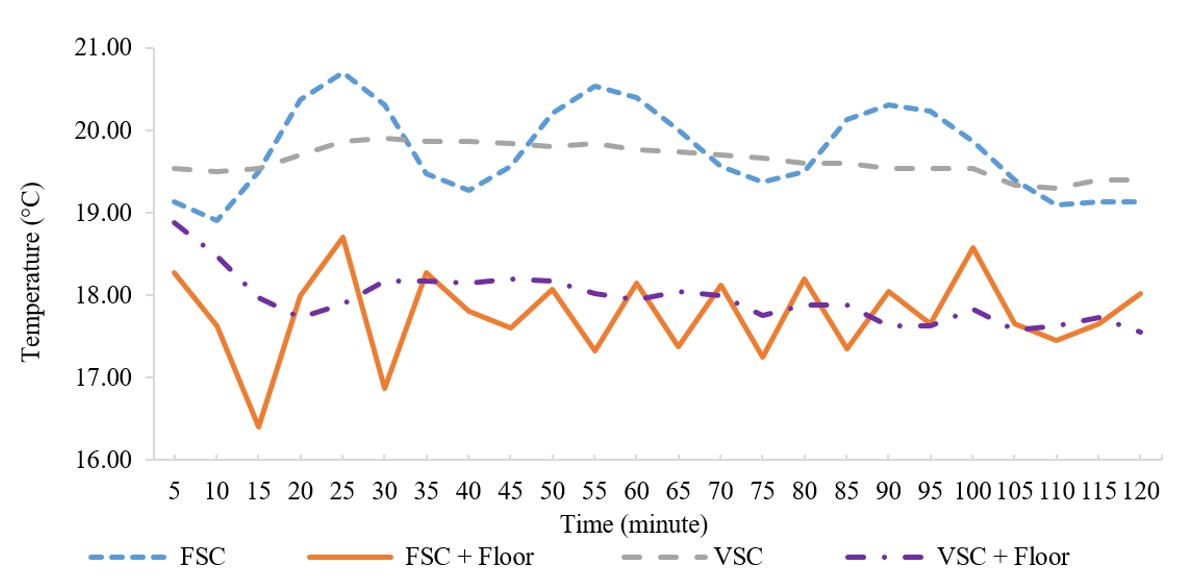Radiant Floor and Traditional Cooling System Applications in Agricultural Product Storages
Main Article Content
Abstract
The fluctuated temperatures and relative humidity inside storages are not suitable for food and agricultural products since these parameters directly affect product moisture contents, freshness, and integrity. With a limited amount of research, in this work, traditional vapor compression (fixed- and variable-speed compressors) and radiant floor cooling systems were experimentally investigated as solo and combined systems in no heat load and heat-loaded cooling-storage rooms. The latter systems were newly introduced in storage applications. When the compression systems were examined, they were set at 18°C and 22°C to find their operating effects. The results showed that the radiant floor cooling systems not only assisted both compression systems to consume less energy, but the floor cooling systems also created fewer fluctuating conditions. The combined systems were highly recommended to be used in storages containing products that were sensitive to fluctuating conditions such as ready-to-eat and fresh fruit products. The energy consumption investigation imparted valuable information for operation costs.
Article Details

This work is licensed under a Creative Commons Attribution-NonCommercial-ShareAlike 4.0 International License.
This work is licensed under a Creative Commons Attribution-NonCommercial-ShareAlike 4.0 International License.
References
Ramírez CA, Patel M, Blok K. How much energy to process one pound of meat? A comparison of energy use and specific energy consumption in the meat industry of four European countries. Energy. 2006;31(12):2047-2063.
Tassou SA, De-Lille G, Ge YT. Food transport refrigeration – Approaches to reduce energy consumption and environmental impacts of road transport. Appl Therm Eng. 2009;29(8-9):1467-1477.
Shen L, Sun Y. Review on carbon emissions, energy consumption and low-carbon economy in China from a perspective of global climate change. J Geogr Sci. 2016;26(7):855-870.
Romphophak T, Kunprom J, Siriphanich J. Storage of durians on a semi-commercial scale. Kasetsart J (Nat Sci). 1997;31(2):141-154. (In Thai)
Srisubati N, Soponronnarit S, Yoovidhya T. Effect of temperature and relative humidity on yellowing rate of paddy. Kasetsart J (Nat Sci). 1998;32(3):309-318. (In Thai)
Chitprasert P, Chedchant J, Wanchaitanawong P, Poovarodom N. Effects of grain size, reducing sugar content, temperature and pressure on caking of raw sugar. Kasetsart J (Nat Sci). 2006;40:141-147.
Lu L, Hume ME, Pillai SD. Autoinducer-2-like activity on vegetable produce and its potential involvement in bacterial biofilm formation on tomatoes. Foodborne Pathog Dis. 2005;2(3),242-249.
Kuna-Broniowska I, Gładyszewska B, Ciupak A. Effect of storage time and temperature on Poisson ratio of tomato fruit skin. Int Agrophys. 2012;26(1):39-44.
Punja ZK, Rodriguez G, Tirajoh A, Formby S. Role of fruit surface mycoflora, wounding and storage conditions on post-harvest disease development on greenhouse tomatoes. Can J Plant Pathol. 2016;38(4):448-459.
Sibomana MS, Ziena LW, Schmidt S, Workneh TS. Influence of transportation conditions and postharvest disinfection treatments on microbiological quality of fresh market tomatoes (cv. Nemo-Netta) in a South African supply chain. J Food Prot. 2017;80(2):345-354.
Tolesa GN, Workneh TS. A comparison of the influence of different low-cost cooling technologies on tomato cooling time and temperature. Acta Hortic. 2020;1275:285-292.
Thole V, Vain P, Martin C. Effect of elevated temperature on tomato post-harvest properties. Plants (Basel). 2021;10(11):2359.
Park MH, Yang HJ, Malka SK. Hormonal regulation of ethylene response factors in tomato during storage and distribution. Front Plant Sci. 2023;14:1197776.
Wen B, Wu X, Boon-Ek Y, Xu L, Pan H, Xu P, et al. Effect of honey and calcium dips on quality of fresh-cut nectarine (Prunus persica L. Batsch). Agr Nat Resour. 2018;52(2):140-145.
Kowitcharoen L, Wongs-Aree C, Setha S, Komkhuntod R, Kondo S, Srilaong V. Pre-harvest drought stress treatment improves antioxidant activity and sugar accumulation of sugar apple at harvest and during storage. Agr Nat Resour. 2018;52(2):146-154.
Klangmuang P, Sothornvit R. Effect of Thai herb essential oils incorporated in hydroxypropyl methylcellulose-based nanocomposite coatings on quality of fresh mango stored at ambient temperature. Agr Nat Resour. 2022;56(2):331-342.
Chu G, Liu X, Gao Q, Guo X, Shen W. Influence of air supply parameters of building atrium on air conditioning effect in winter. Procedia Eng. 2017;205:1913-1919.
Janthasri P, Pramuanjaroenkij A, Kakaç S, Chungchoo C, Ngamvilaikorn T. Energy consumption comparison of two cooling systems equipped with the heat exchangers in different agricultural postharvest storage conditions. Therm Sci Eng Prog. 2024;48:102419.
Sastry G. First radiant cooled commercial building in India - Critical analysis of energy, comfort and cost. World Energy Engineering Congress (WEEC 2012); 2012 Oct 31-Nov 2; Atlanta, USA. USA: Association of Energy Engineers (AEE); 2012. p. 1474-1479.
Khan Y, Khare VR, Mathur J, Bhandari M. Performance evaluation of radiant cooling system integrated with air system under different operational strategies. Energy Build. 2015;97:118-128.
Sokołowski P, Nawalany G. Analysis of energy exchange with the ground in a two-chamber vegetable cold store, assuming different lengths of technological break, with the use of a numerical calculation method—A case study. Energies. 2020;13(18):4970.
Mizuno S, Muramatsu Y, Tateishi A, Watanabe K, Shinmachi F, Koshioka M, et al. Effects of root-zone cooling with short-day treatment in pot-grown strawberry (Fragaria × ananassa Duch.) nurseries on flowering and fruit production. Hort J. 2022;91(1):1-7.



